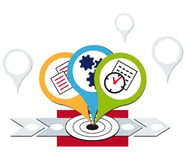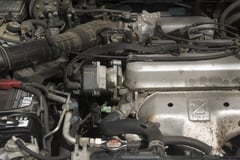How Industry 4.0 Will Improve Your Demand Forecasts
Brian Hoey - December 31, 2020

If you ever go to Las Vegas, you should be advised that casinos heavily frown upon card counting, and it’s easy to understand why. A game like blackjack is supposed to be more or less random in terms of what cards are dealt when, which puts the house at an advantage. Over the course of several hands (before the entire deck has been reshuffled), however, a careful observer can note the proportion of face cards that have come out in order to come up with a rolling estimate of how likely or unlikely they are to come up in future hands. This puts the player at a real statistical advantage over the house—at least until the casino politely (or not so politely) asks her to leave.
Though turning large caches of seemingly random information into probabilistic insights isn’t allowed in casinos, it’s a mission critical business necessity in the world of supply chain management. Unfortunately, it’s usually not something that individuals can grapple with on their own. Why? Because the sheer amount of data produced by the average factory, shipping network, or value chain is simply too much to be analyzed on paper. Historically, this has made things like customer demand for particular products notoriously hard to predict. But in the era of Industry 4.0, that might be changing.
Challenges in Demand Forecasting
Like we said above, demand forecasting has historically been a bit of a crapshoot, as most businesses have only been able to rely on past demand as an indicator of future orders. This can be an issue for two reasons:
- Past orders don’t always have an obvious pattern do them. There might be spikes or dips in demand that are difficult to explain, and thus difficult to incorporate into future predictions.
- Relying on past orders presupposes that things in the supply chain will carry on as usual in the future, when in point of fact the industry is constantly evolving. If you’re trying to capture the likely impact of a new technology, a new market trend, or even emerging trade conditions, a reactive strategy that relies too heavily on past data will make it hard to account for these trends.
Thus, planners need to move beyond past data—but what should they utilize in its place? Gut intuition has often been a popular choice, but it’s obviously fallible. Data-driven solutions typically seem like a better bet, but they can present their own challenges. Specifically, truly data-driven forecasting requires not just that you collect and properly stores huge caches of data, but also that you have the IT infrastructure to process that data. If you’re using sensors to capture everything that happens on your factory floor and then exporting that sensor data into an Excel spreadsheet, you’re going to run into many of the same problems we discussed above. Conversely, you might find yourself completely overwhelmed by the sheer number of data points and unable to form any conclusions.
Integration, IT Improvements, the Industrial IoT, Oh My!
As adoption rates for things like the IIoT (industrial internet of the things) begin to tick up, aggregating large quantities of data is becoming less and less of a stumbling block. Admittedly, as of 2015 only about a quarter of manufacturers were utilizing IIoT devices, but that number has surely ticked up since then, and estimates suggest that the IIoT could add 7 trillion to the US GDP in the next decade or so. Likewise, more emphasis has been placed recently on IT integration both up and downstream in the supply chain, leading to improved end-to-end visibility.
IoT and general IT integration are, of course, important pillars of Industry 4.0. In order to improve forecasts (and thus sales and operations planning processes), however, you also need to emphasize one of the other pillars of this new technological paradigm: advanced analytics. Essentially, advanced predictive analytics are the tool that lets you actually extract value out of large caches of information. If, for instance, you were trying to arrange deals for the coming quarter with your suppliers of raw materials, you would want to have an estimate not just of total demand but of demand for individual products, such that you could order the right ratio of parts and materials. By feeding information from your own order logs, your suppliers’ IT solutions, and the market in general into an advanced analytics workflow, you could get a much more accurate picture of future demand than you could possibly have generated by hand. In this way, you marry the two elements of Industry 4.0 that can help power improved demand forecasts: smarter data collection and more sophisticated data analysis.
Powering S&OP/S&OE
Okay, we alluded to this briefly above, but let’s be a little more explicit about the value of accurate demand forecast. Because S&OP runs on matching supply to quarterly estimates of demand, Industry 4.0-powered forecasts have the ability to reduce the disruptions that arise from creating too much or too little supply. Though there is always some risk that you’ll over-produce and have to pay for expensive warehousing, or that you’ll be behind on order fulfillment and thus stuck paying for premium freight to meet demand in a timely way, this kind of disruptions should happen far less frequently. As a result, you’ll have an easier time predicting and managing costs.
As it happens, Industry 4.0 connectivity also has the ability to power sales and operations execution (S&OE) workflows that bridge the gap between daily supply chain operations and quarterly planning cycles. By providing S&OE planners with real-time data and empowering them to make small adjustments to inventory levels and transport plans on an as needed basis. This kind of process adds flexibility and helps to prevent widening gaps between expectations and reality—meaning that it helps to turn your forecasts into living, dynamic documents that change as new information emerges. In this way, your larger S&OP processes can become ever more proactive, resulting in further cost optimization.
If you want to learn more get your Guide to Sales & Operations Planning
In this Guide you will learn:
-
Why a S&OP Process is important
-
How a S&OP System can be flexible and quickly implemented
-
Central tasks of a S&OP System
-
The key to more productivity
LATEST POSTS
- Understand Circular Economy in The Manufacturing Industry
- How Can Industry 4.0 IT Integration Be Achieved Smoothly?
- The Significance of Order Sequencing in Discrete Manufacturing
- How to improve your Supply Chain Management: The Power of Control Towers
- Optimizing Human Resource Scheduling in Manufacturing: A Technological Approach



